Lec 8 - Knowledge & Imagery
1/29
Earn XP
Description and Tags
texbook chapters 9 & 10
Name | Mastery | Learn | Test | Matching | Spaced |
|---|
No study sessions yet.
30 Terms
What is…
conceptual knowledge
concept
categorization
Why do we use categories?
Analogy for ‘concept’ vs ‘categorization’:
Think of a concept as the folder on your computer labeled “Birds,” and categorization as what you do when you find a new photo and decide, “Yep, this goes in the ‘Birds’ folder.”
Why do we use categories?
organization enables efficient thinking
allows us to identify unique characteristics & retrieve them easily
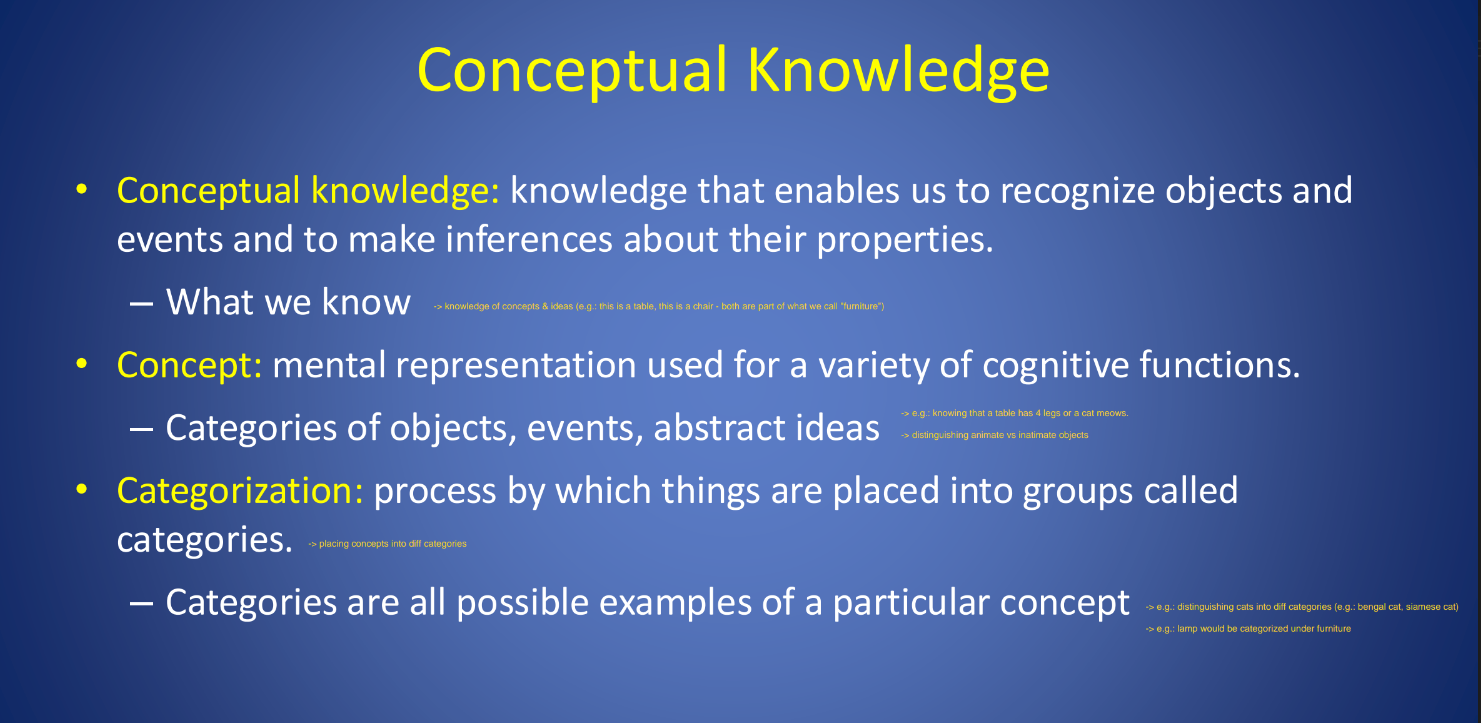
What is the definitional approach to categorization? Why doesn’t it work well?
What is family resemblance?
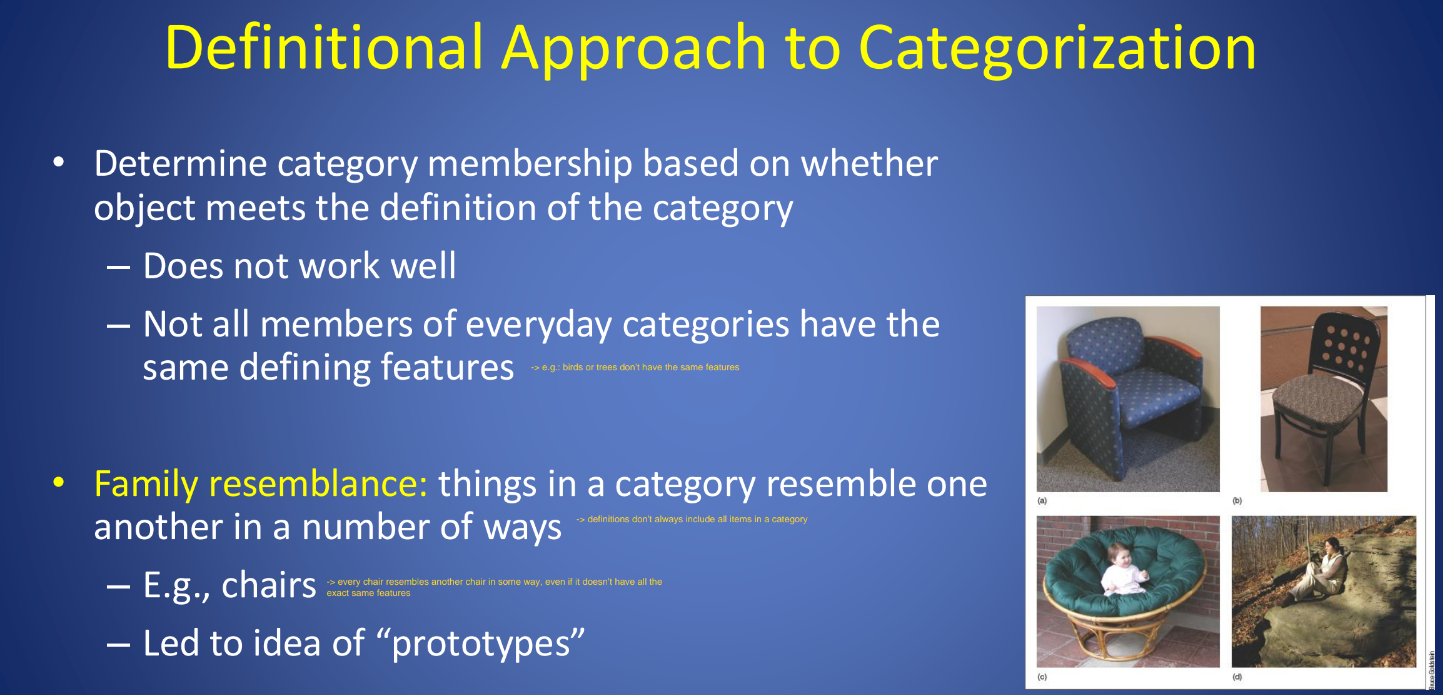
What is the prototype approach to categorization?
What is ‘high typicality’ & ‘low typicality’?
What’s the relationship b/w typicality & family resemblance?
What is the typicality effect?
Strong positive relationship between
prototypicality and family resemblance.
item w/ large amount of overlap with characteristics of other items in the category = family resemblance of these items is high.
Typicality Effect: Items w/ high prototypicality are processed preferentially
e.g. when asked to list items from ‘fruit’ category, we think of ‘apple’ before ‘pomegranate’. We’re also faster @ determining that ‘apple’ belongs to ‘fruit’ category.
occurs w/ colors too - we process rich green (primed color) more preferentially than light green (low typicality)

What is the exemplar approach to categorization?
What are its advantages?
Advantages of Exemplar Approach:
By using real examples, it is easier to take into account atypical cases (better at handling variability).
Better at explaining how categories develop – we build categories from real-world experience, not just from an abstract prototype.
– Prototypes may work best during initial learning (e.g.: in early development, we don’t have a lot of examples we’ve encountered)
– Exemplars may work best later in learning
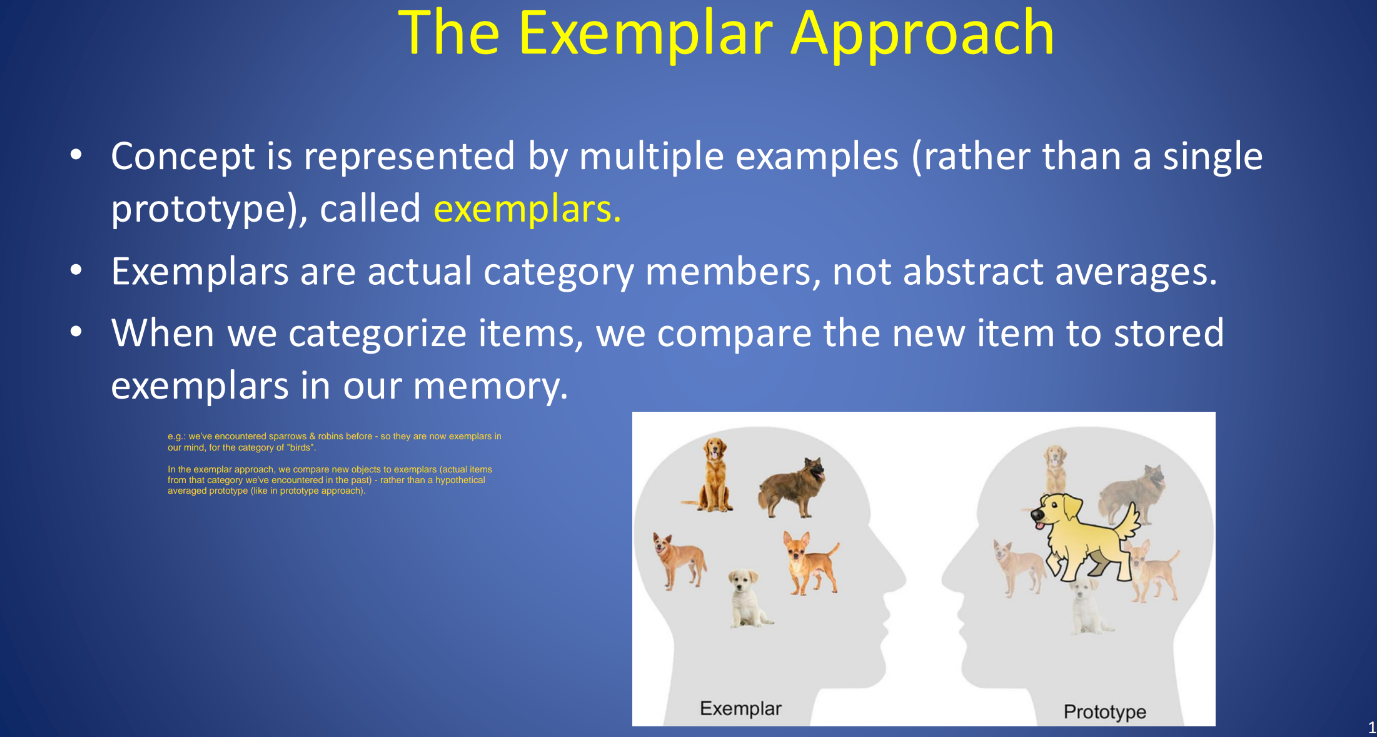
What is hierarchical organization?
Which level is most important?
Hierarchical Organization: Larger, more general categories can be divided into smaller, more specific categories.
The level that is most important, depends on the person’s knowledge. Experts are more likely to name things at the ‘specific’ level - while novices name @ ‘basic’ level.
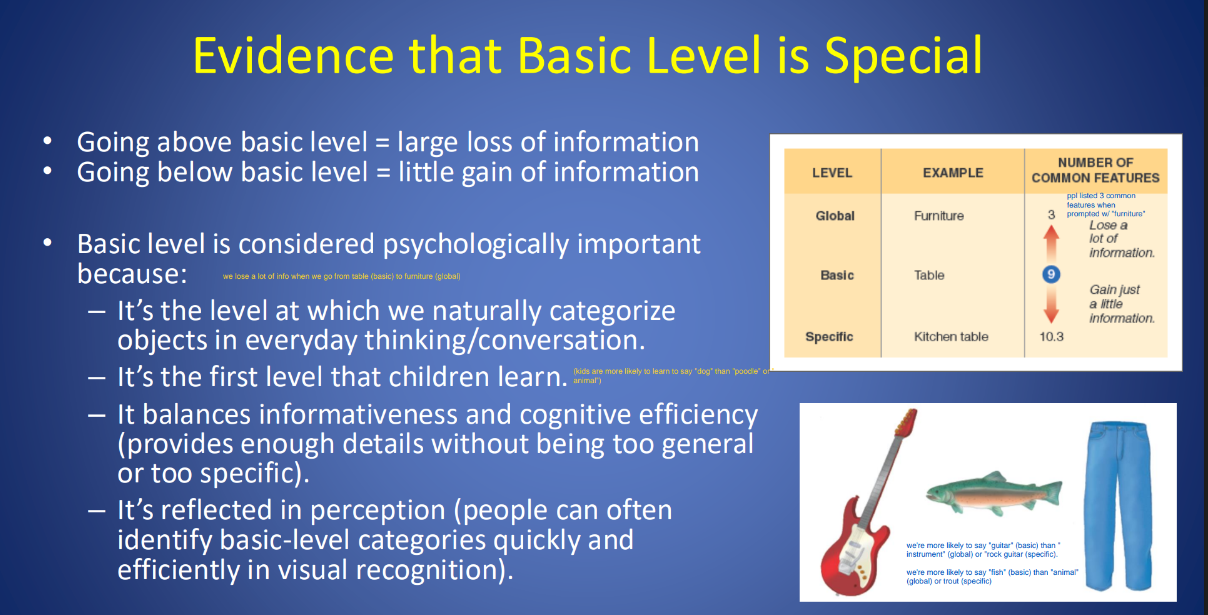
What is the semantic network approach of categorization?
What is the cognitive economy?
The more nodes you need to travel to access info, the longer the reaction time (‘a canary is an animal’ has longer reaction time than ‘a canary is a canary’)

What is spreading activation?
What did Meyer & Schvaneveldt (1971) discover in the lexical decision task about word pairs?
When asked to determine if 2 words are words or non-words, RT was faster when the two words were related, as retrieving one word from memory triggered a spread of activation to other nearby locations in a network.
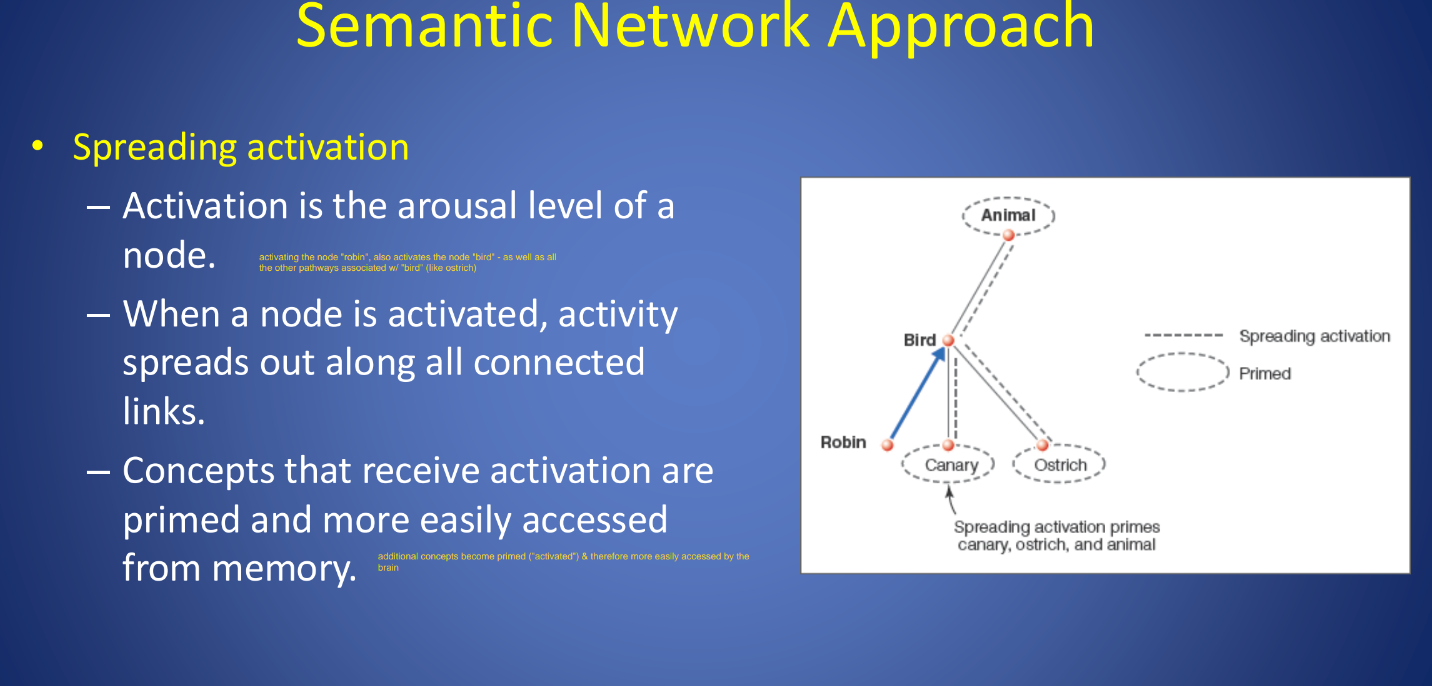
What are criticisms of the semantic network approach?
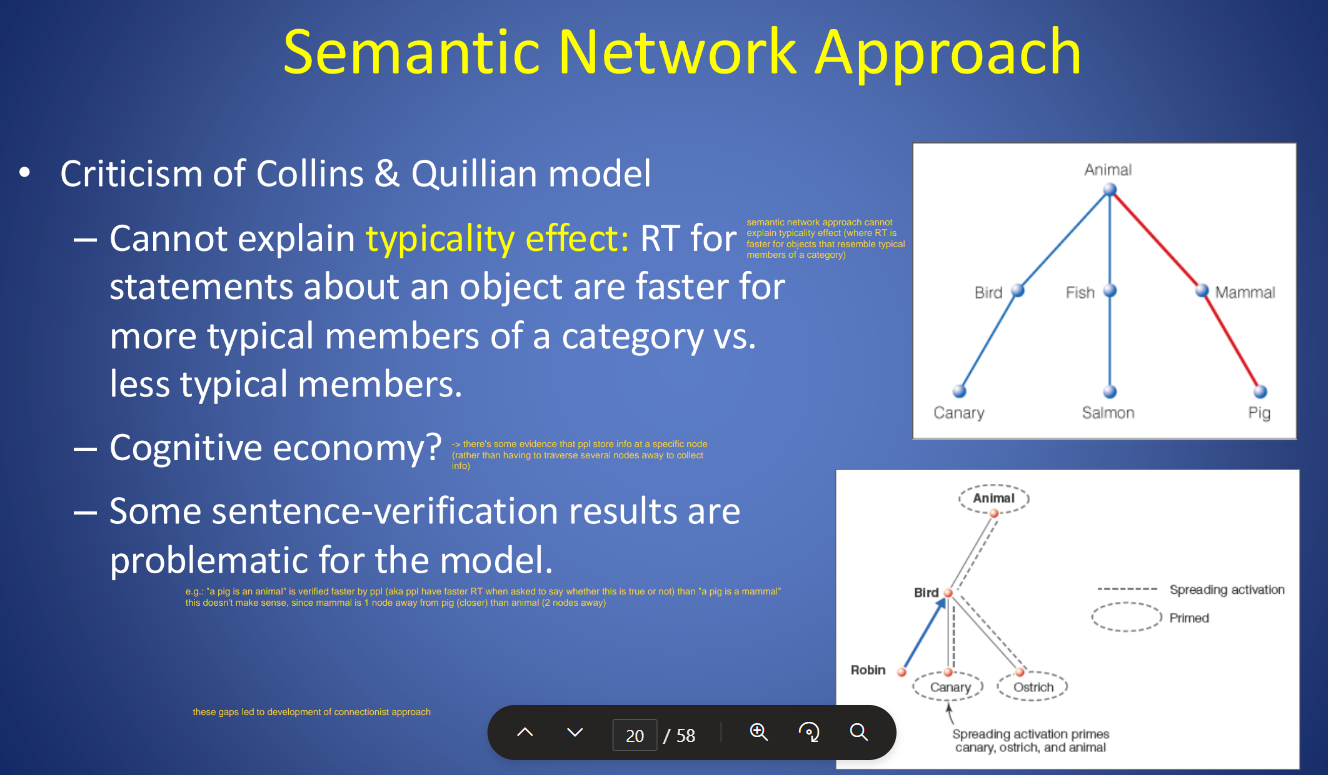
What is the connectionist approach/Parallel distributed processing (PDP) model?
What 2 things does activation of a unit depend on?
Activation of units in a network depends on:
– 1. the signal that originates in the input units
– 2. the connection weights throughout the network, that determine how strongly a unit will be impacted by incoming activity.
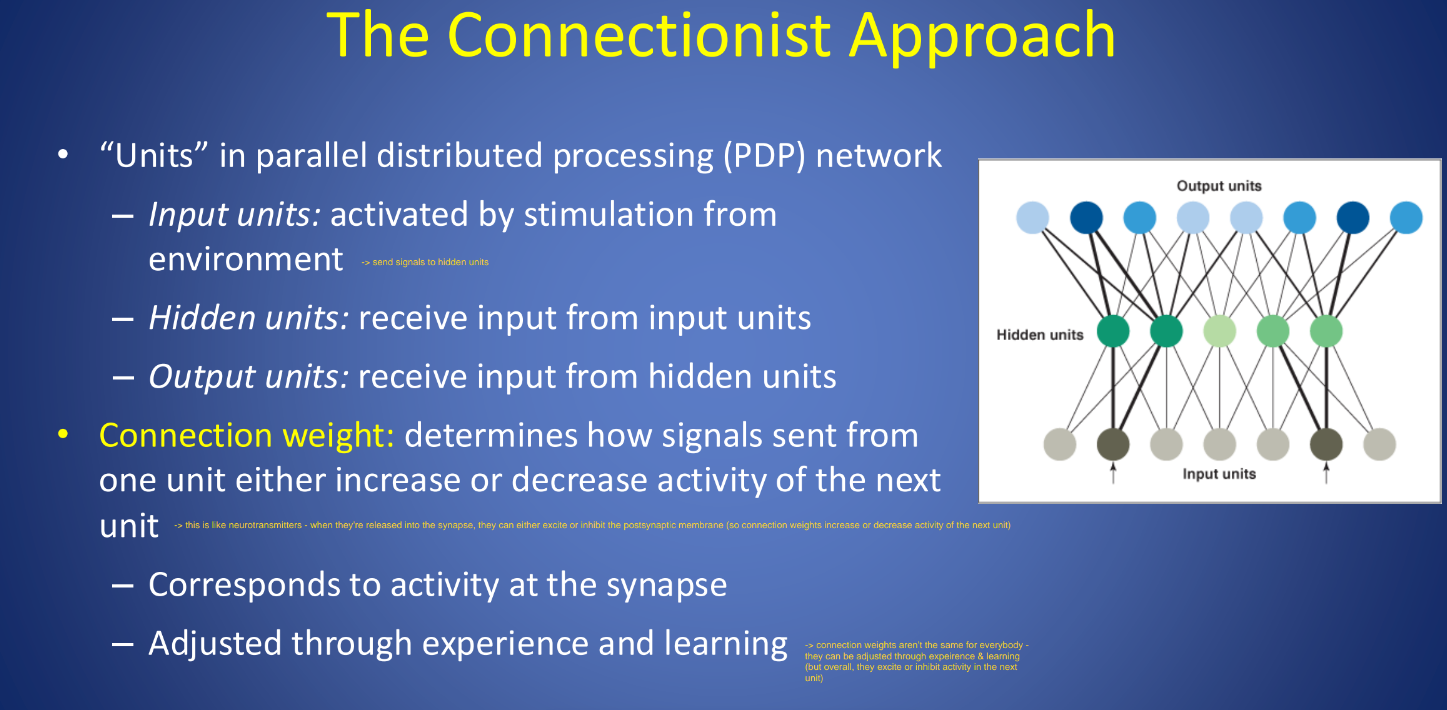
Why is learning importat in the PDP model?
What is back propogation?
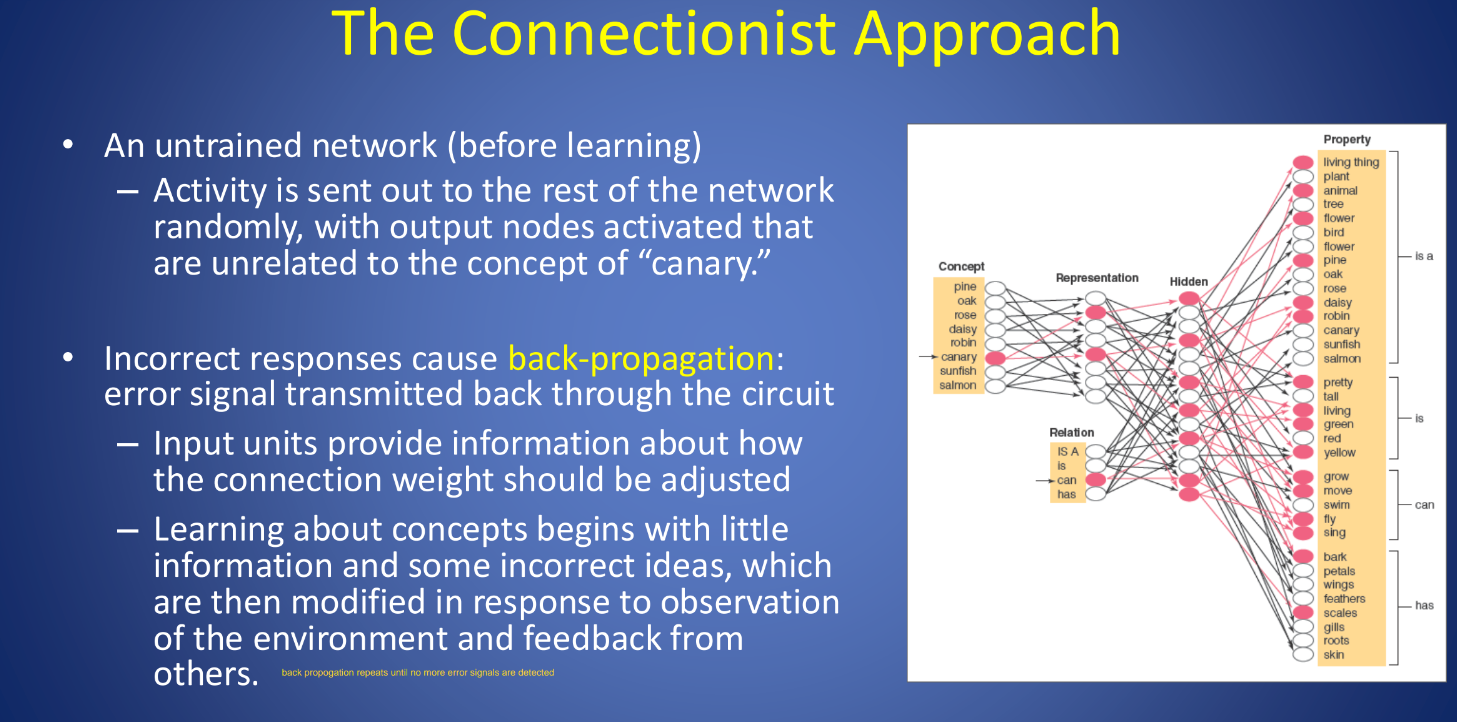
What is graceful degredation?
Performance disruption occurs gradually as parts
of the system are damaged (e.g.: brain injury causes partial loss of functioning)
What is the sensory functional hypothesis?
What was SF hypothesis unable to explain?
1 of 4 ways we represent concepts in the brain.
Our ability to differentiate living things & artifacts, depends on 1 memory system that disinguishes sensory attributes (e.g.: tiger has stripes) from functions (e.g.: hammer is used to hit nails)
SF hypothesis was unable to explain…
why some ppl are able to better identify animals than artifacts
why some ppl are able to identify some artifacts, but not others.
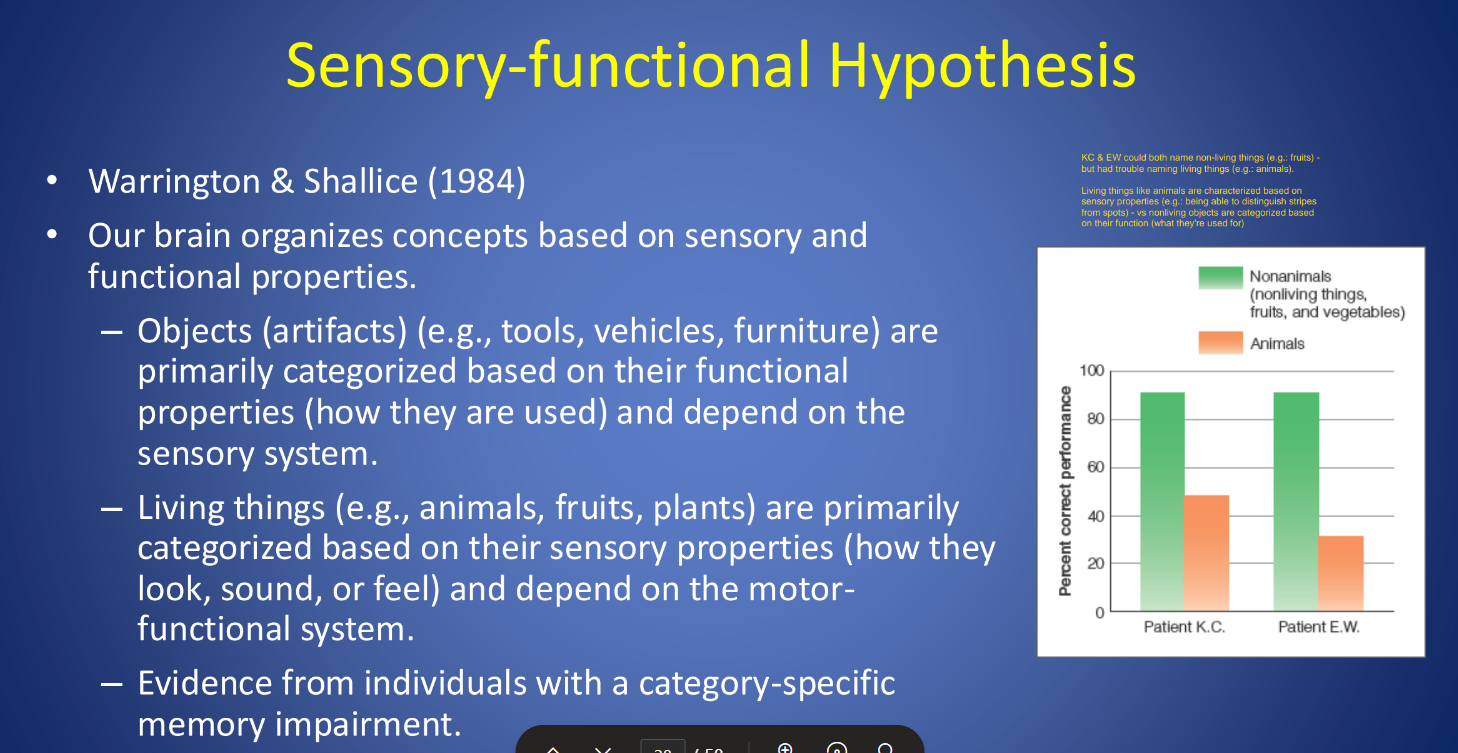
What is the multiple factor approach?
What is crowding?
1 of 4 ways we represent concepts in the brain.
Crowding: when different concepts within a category share many properties, making them harder to distinguish from one another
living objects like “animals” all share “eyes”, “legs,” and “the ability to move”.
non-living objects have less features in common.
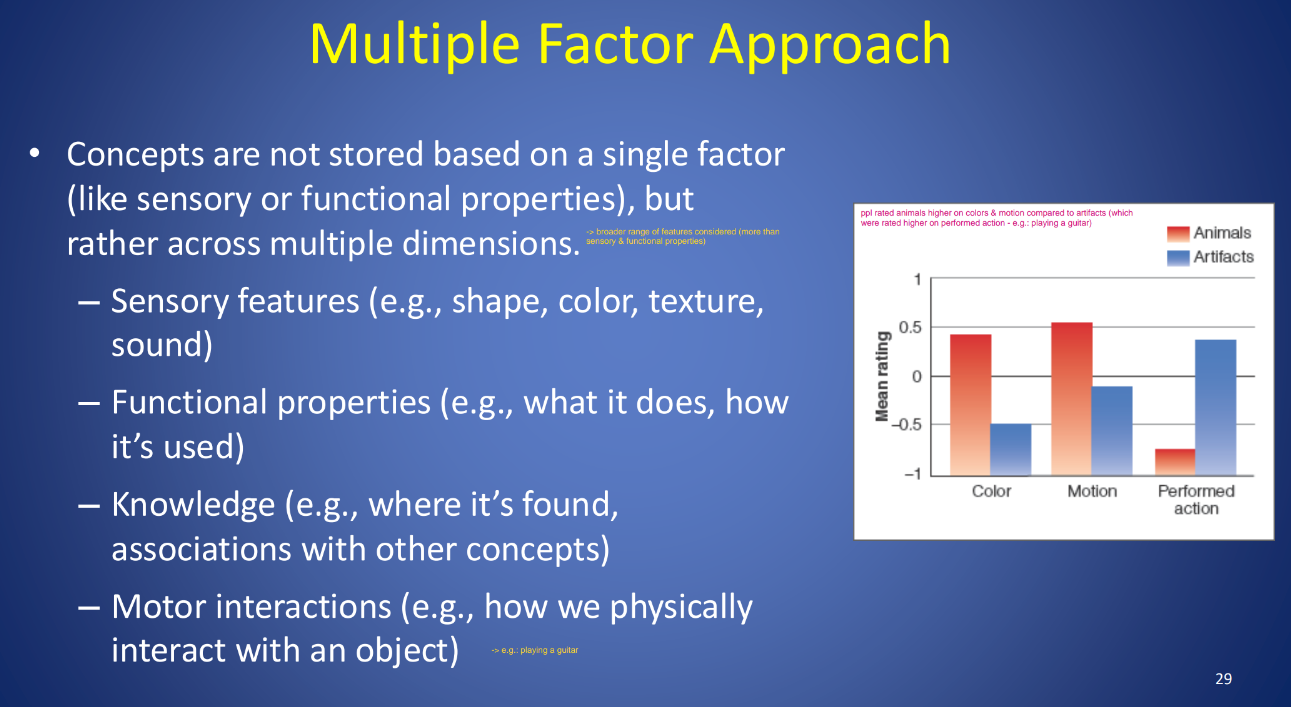
What is the semantic category approach?
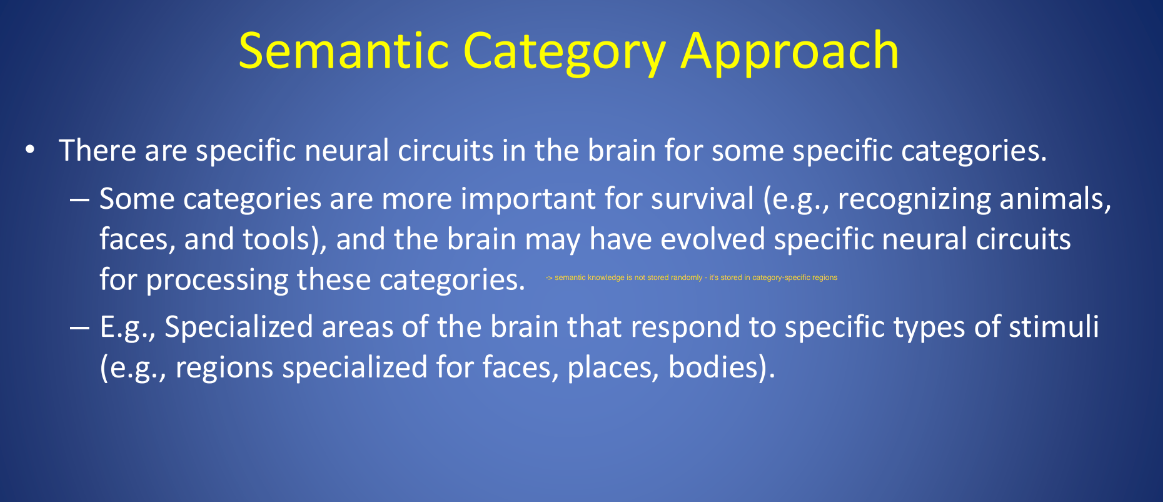
What is the emobodied approach & some of its criticisms?
What is semantic somatotopy?
Semantic somatotopy: Correspondence between words related to specific body parts and the location of brain activation.
Criticisms of Embodied Approach:
being able to produce motor actions is not necessary for identifying objects (one can identify a hammer, even if they can’t reproduce the motor action associated w/ it.
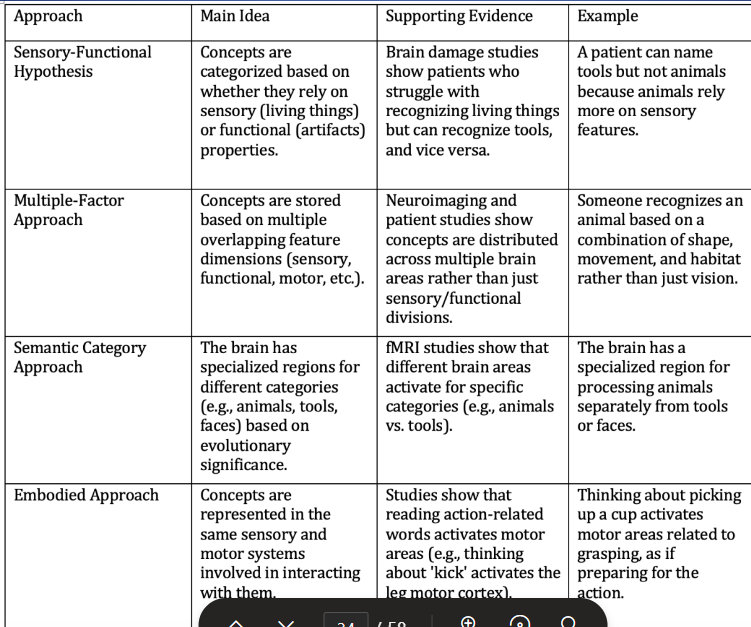
What is visual vs mental imagery?
Note: Watson (behaviourist) didn’t believe imagery was real, since it wasn’t tangible.
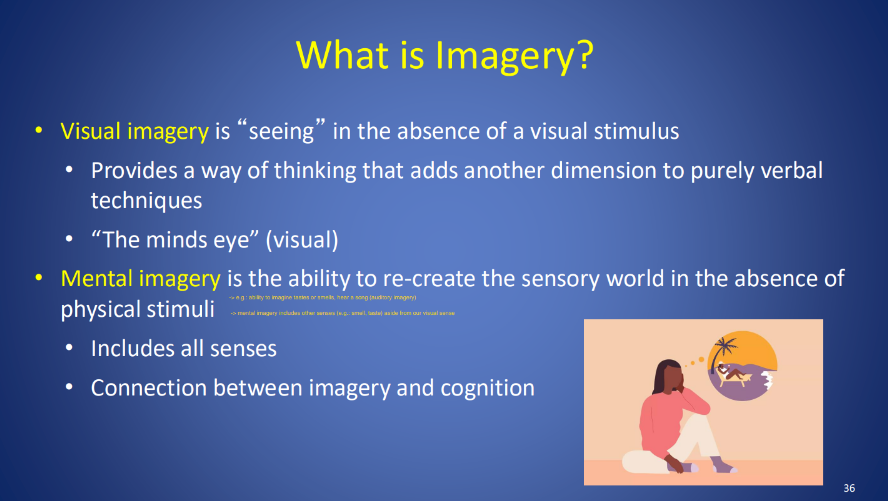
Imagery Debate
Debate over whether imagery is spatial or propositional (relies on remembered facts than mental images)
What is the conceptual peg hypothesis?
Concrete nouns (e.g.: apple) evoke mental images (like a peg/hook) - which helps us remember other words (e.g.: truth), since they can hang onto the peg (e.g.: an apple w/ the word ‘truth’ carved in it)
Mental Chronometry
The time it takes to perform cognitive tasks (measured via reaction time)
Mental Scanning Experiments: what are they & what did Kosslyn’s (1973) & (1978) experiments find?
Mental Scanning Experiments: Participants create mental images & scan them in their minds.
Kosslyn (1973):
Participants had longer RT when trying to scan larger distances of the image.
Proves that imagery is spatial, like perception is!
Kosslyn (1978):
when asked to imagine 2 objects (e.g. fly & rabbit), 1 object was always imagined as larger than the other (e.g. rabbit larger than fly).
ppl could more easily recall details associated w/ the larger object.
Mental Walk Task: Ppl moved closer to the small objects before experiencing ‘overflow’ (images filling visual field).
1 foot away from small object compared to 11 feet away from big object.
Propositional Representation
Remembering info not as a mental image (depective/spatial representation), but as a description (like a sentence).
(e.g. when asked if the gas station is before or after the supermarket, you recall a series of facts like how the park is after the supermarket, rather than using a mental image of a map of the community).
What are imagery neurons?
Neurons that fire in the same way when a person sees a picure of an object & when they create a mental image of it in their mind.

What are the activity levels of the frontal lobes & occipital lobe (visual cortex) during perception vs imagery?

What is unilateral neglect (or hemispatial neglect)?
Does it occur for both perception & imagery?
Why does it occur?
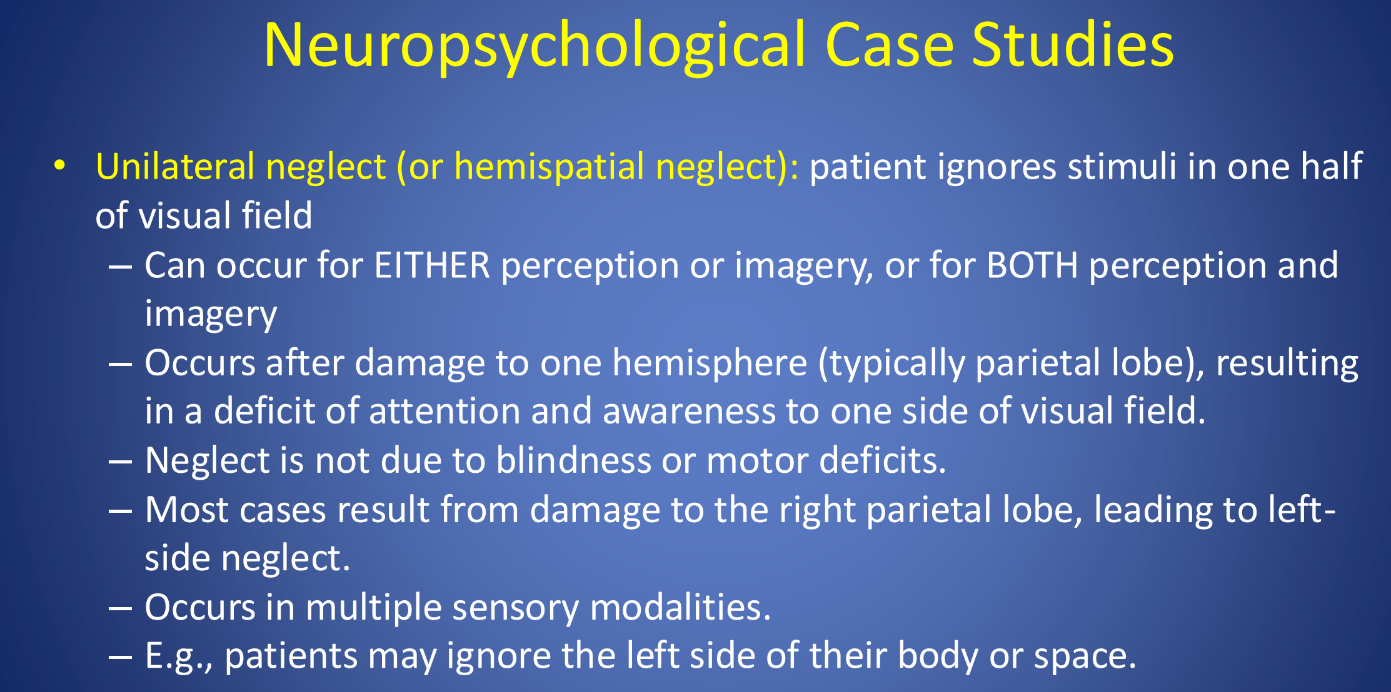
Describe Patient R.M & C.K’s cases
What is visual agnosia?
R.M. = Real Life Master (perception ok, imagery bad)
good with real-life objects (can see, recognize, draw them when they’re in front of him)
can’t imagine things — can’t draw from memory, struggles with questions that need mental images
C.K. = Creative Kid (perception bad, imagery good)
Visual Agnosia: inability to recognize or name objects he sees (like a kid who’s bad at identifying things)
has a great imagination — can draw things from memory perfectly
Perception is _______ and _________, while imagery takes effort and is ________.
More difficult to manipulate (mental images vs. images created perceptually).
Perception is automatic and stable, while imagery takes effort and is fragile.
More difficult to manipulate mental images vs. images created perceptually.
What is aphantasia?
condition in which one is unable to voluntarily visualize imagery (mind blindness).
they know what objects are, but can’t visualize them.
Method of Loci
A method for remembering things, where the items to be remembered are placed @ different locations in a mental image of a spatial layout (e.g.: at different seats around a banquet table).
Pegword Technique
Method for remembering things by…
creating a list of words (pegwords) that rhyme w/ numbers (e.g.: one = bun, two = shoe).
create a vivid mental image linking the pegword to the item you’d like to remember (e.g.: apples in a bun)
What is spatial vs object imagery?
Spatial Imagery: Ability to image spatial relations (e.g.: layout of a garden).
Object Imagery: Detailing visual features or objects (e.g.: rose bush w. bright red roses)